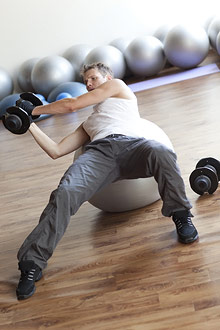Did You Know...
04/23/2012
Furci Home / Fitness Channel / Bullz-Eye Home
A column by Mike Furci that brings you research, trends and other info to help you with your fitness, health and nutritional needs.
...the use of a towel or pad around the bar when squatting will decrease the stability of the exercise, because it pushes the bar higher and farther back on the shoulders with less of the bar coming in contact with the body? Wrapping a towel around a bar or using a pad also increases the distance between the bar and the hips, which increases the tension on the lower back. This practice also places more pressure on the cervical vertebrae, and creates a tendency to push against the bar with your neck. The main reason people use a towel or pad is because they find it uncomfortable to hold the bar on their shoulders. I have found that most people haven't been properly instructed in technique. If you find it painful to hold the bar on your shoulders while squatting, try a closer grip -- place the bar on top of your traps and point your elbows down. Many beginners place the bar too high on their necks, use too wide of a grip, and point their elbows back.

...stability ball training has gained wide acceptance as a means to injury prevention, and has permeated training protocols of many strength and conditioning coaches and personal trainers? Despite the popularity of core stability training, little scientific research demonstrates the benefits for healthy athletes.
Stability balls got their start in the rehab setting for individuals with lower back injuries. It's been established that stability ball exercises are effective for pre-existing injuries, detrained individuals and weaker older adults. Proponents of this type of exercise commonly cite studies using these weaker, unhealthy populations. These studies use low loads, isometric contractions and a long time under tension. These training modalities are not conducive to developing core stability for healthy individuals. If you want to make the most out of your training time, use traditional exercises like the squat, deadlift, Romanian deadlifts, power cleans and pulls to strengthen your core.
Journal of Strength and Conditioning Research, 2007,21(3), 979-985
 ...there is more and more evidence showing if a healthy individual wants a strong core, instability exercises don't cut it? Core stabilizer training has become extremely popular in the past few years. I am starting to see a trend toward the core being the "core" of training programs. This shouldn't be the case, and there is a tremendous amount of data showing the benefits of basic weight training exercise. In this newly published study, researchers used 16 physically active subjects. The purpose was to compare the activation of various trunk muscles with selected weight training exercises (squat and deadlift) and Swiss ball unstable calisthenic-type movements (superman's and side bridging). The researchers concluded it is unnecessary to incorporate unstable callisthenic-type exercise if you are performing exercises like the squat and deadlift. Basic heavy exercise is the key to a strong, healthy core.
...there is more and more evidence showing if a healthy individual wants a strong core, instability exercises don't cut it? Core stabilizer training has become extremely popular in the past few years. I am starting to see a trend toward the core being the "core" of training programs. This shouldn't be the case, and there is a tremendous amount of data showing the benefits of basic weight training exercise. In this newly published study, researchers used 16 physically active subjects. The purpose was to compare the activation of various trunk muscles with selected weight training exercises (squat and deadlift) and Swiss ball unstable calisthenic-type movements (superman's and side bridging). The researchers concluded it is unnecessary to incorporate unstable callisthenic-type exercise if you are performing exercises like the squat and deadlift. Basic heavy exercise is the key to a strong, healthy core.
Journal of Strength and Conditioning Research, 2007,21(4), 1108-1112
...the benefits of supplementing with creatine, the most-studied supplement on the planet, are nothing short of amazing? Canadian researchers compared the changes of insulin-like growth factor-1 (IGF-1) amounts in two groups of subjects. All the subjects performed at least 30 minutes of structured physical activity three to five times per week for eight weeks. The subjects were randomly assigned to one of two groups: one supplementing with creatine, the other an iso-caloric placebo. Muscle biopsies were taken before and after the training period and analyzed for IGF-1 content. The creatine group had a 24 percent higher level of IGF-1. The creatine group also had a 23 percent higher increase in type II muscle fibers. These findings were independent of dietary guidelines. (Int J Sport Nutr Exerc Metab, 2008; 18(4))
What does this mean for the average lifter? It means if you supplement with creatine, you'll not only get the well known "volumizing" effect, but more type II muscle fibers. Type II muscle fibers respond to progressive resistance training and account for almost all size and strength gains.
You can follow us on Twitter and Facebook for content updates. Also, sign up for our email list for weekly updates and check us out on Google+ as well.













